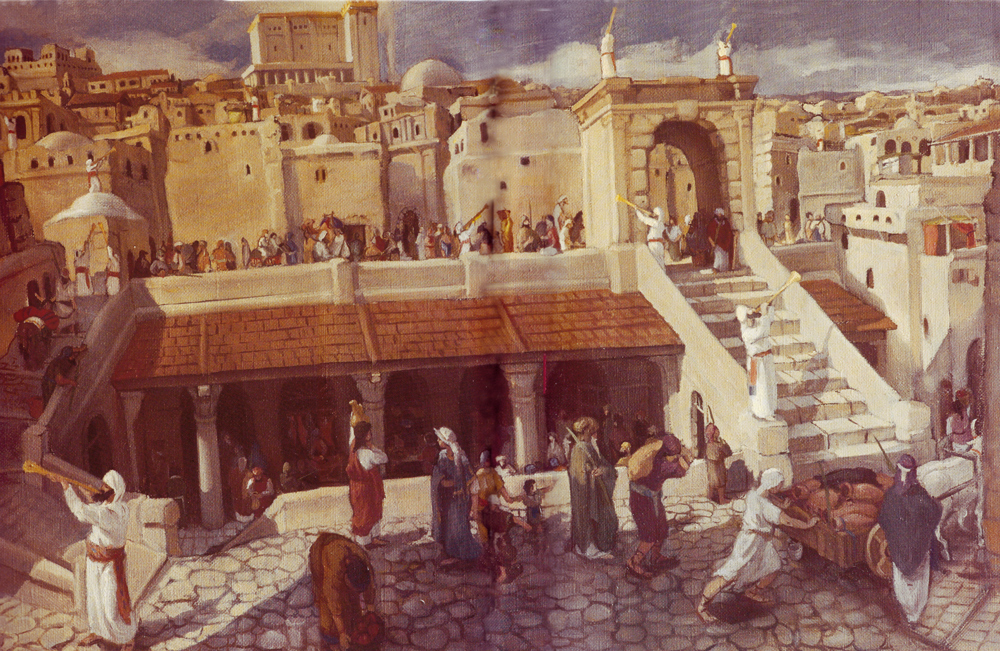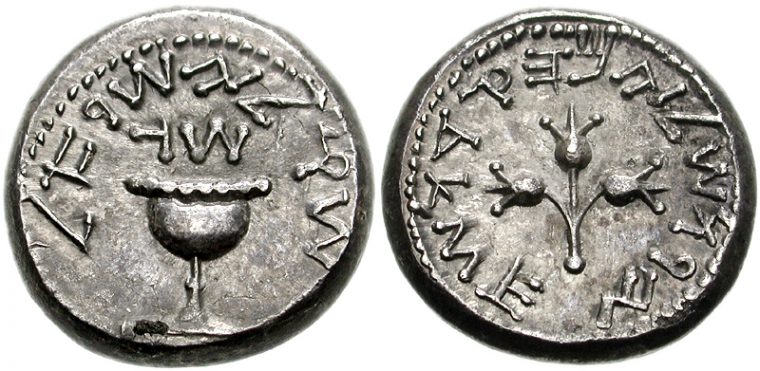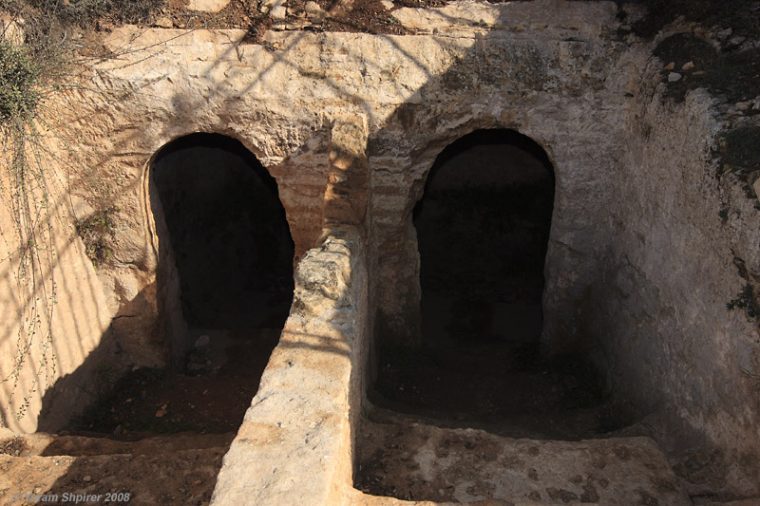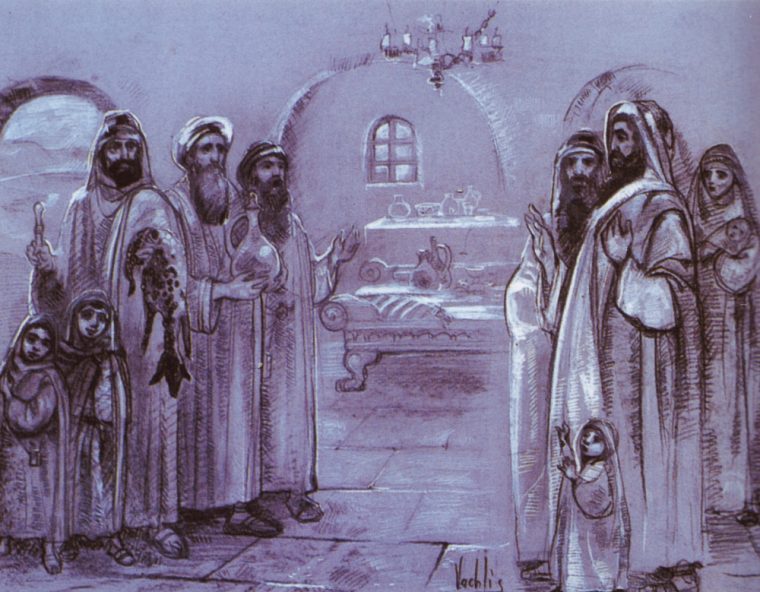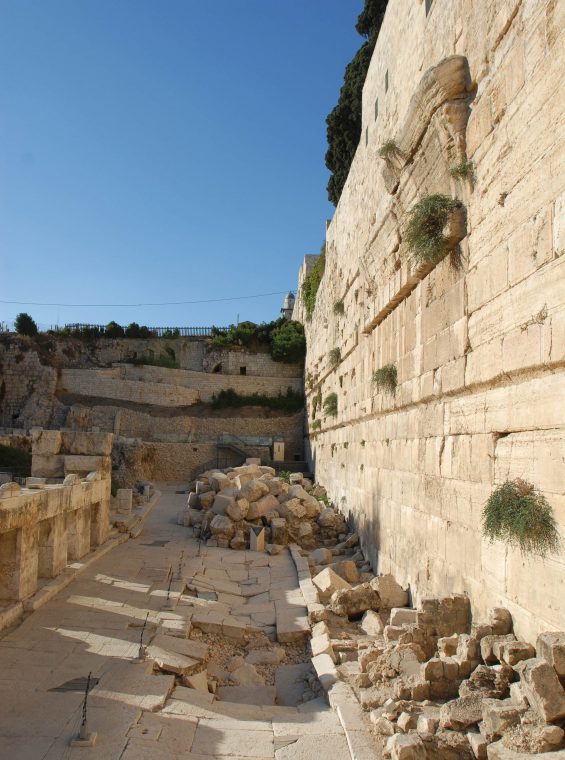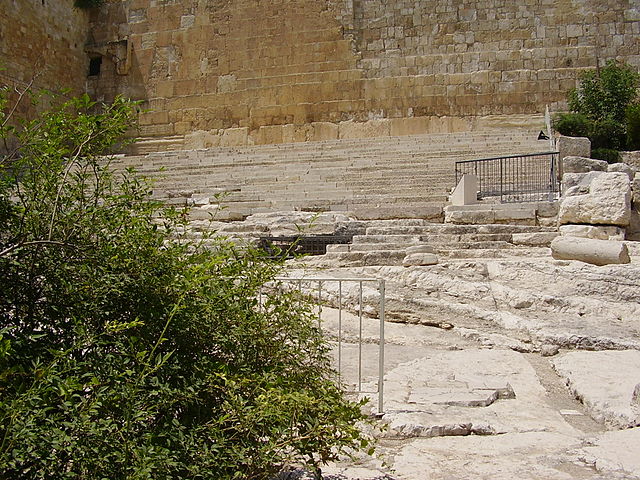First Century Pilgrimage
It is difficult for us to imagine how the Biblical command of Aliya LeRegel, or pilgrimage, impacted on the lives of Jews some two thousand years ago. When we picture Pesach, we think of the family seated around the Seder table. Sukkot brings to mind the backyard booth filled with relatives and neighbors. Shavuot is blintzes and all night learning. But if we were to transport ourselves back to the times when the Temple was standing, preparation for the holiday season would not consist of frantic shopping, cooking and cleaning. Rather we would be packing our tent and saddling up the family donkey as we set out on our journey to Jerusalem.
Actually, once the Jewish people spread throughout the Diaspora, it was impractical for many people to embark on the pilgrimage that often. The trip from Babylonia could take up to three weeks. Imagine arriving home three weeks after the end of Passover, only to have to turn around again and return for Shavuot! Yet despite the fact that many Jews could not go for every holiday, all Jews attempted to go to Jerusalem when they could. And for those who couldn’t make it one year, the law provided a vicarious way to be involved – the half shekel tax.
Donate and Partake
The pilgrimage “season” officially began with the holiday of Pesach. Six weeks prior to that, at the start of the Hebrew month of Adar, preparations would begin: “On the first of Adar, they would announce the gift of shekalim…” (Mishna Shekalim 1:1)
All Jewish adult males were required to give an annual tax to the Temple. Although this idea originated in the book of Exodus, when money was used as a method of counting the people, by the late Second Temple period the amount was fixed at a half a silver shekel per household. Since the value of coins in the ancient world fluctuated, the rabbis mandated that the only coin that could be used to pay the tax was a silver half shekel minted in Tyre (in Lebanon of today), a city that was known to have a reputable mint. These coins, which had a striking design of an eagle on one side, have been discovered on the ancient streets of Jerusalem. Caches of them have also been discovered elsewhere, for example in the Druse village of Ussafiya near Haifa. This makes sense since, as the Mishna explains, the coins were purchased at local moneychangers throughout the country:
On the fifteenth of Adar, moneychangers would sit in the country (outside Jerusalem), on the twenty-fifth they would sit in the Temple. (Ibid, 1:3)
The money collected for the half shekels was used for the many needs of the Temple and its service, but another goal of the tax was to enable all Jews, even those who lived too far away to make the pilgrimage on a regular basis, to feel a connection to the Temple.
The Way to Jerusalem
What was Aliyah LeRegel like for those who did make the trip? Piecing together the text of the Mishna with information from the archaeological finds of the past few decades, we can reconstruct the pilgrim experience. Jews would arrive in Jerusalem, often with whole families in tow, from all over the Diaspora as well as the Land of Israel. Jews living in Egypt, Babylonia, Asia Minor, even as far away as Rome would mingle with Jews from the land of Israel. Imagining a typical pilgrim and his family, we can follow in their footsteps as they make their way to the Temple.
The Sanhedrin was charged with preparing the roads for the travelers: “On the fifteenth of Adar… they repair the roads… and the ritual baths… and mark the graves .” (Ibid, 1:1)
Everyone was allowed to ascend to the Temple Mount with the proviso that he or she was ritually pure. Therefore, working ritual baths were crucial, as was the clear marking of graves so that those travelers who were already pure were not defiled by accidentally stumbling upon a grave. A beautiful illustration of this mishna was discovered a few decades ago between the towns of Alon Shvut and Elazar in Gush Etzion. Derekh HaAvot, the Path of the Patriarchs, wends its way from here towards Jerusalem. This is the ancient north-south road through the center of the country, leading from Beersheba to Jerusalem via Hebron and continuing north towards Shechem (Nablus). Recent theories suggest that it was part of a system of paths made and maintained specifically for the use of pilgrims headed for Jerusalem.
By the time any pilgrim coming from the southern part of the country reached this portion of the road, they were about a half-day’s journey from Jerusalem. Here, at the roadside, with no settlement nearby, the most impressive ritual bath in Israel was discovered.
The installation is enormous, with two arched entrances and two separate staircases leading to the pool, one for those descending in an impure state, and one for those ascending, purified and prohibited from contact with anyone still impure. Such a large and elaborate mikveh in such a location could only be intended for the use of travelers, and it is a poignant reminder of the vibrant scene here two thousand years ago.
The Pool of Meeting and Greeting
When our pilgrim family arrived in Jerusalem, their first stop was likely to have been the Siloam (Shiloach) Pool at the southern edge of the city. This pool is fed by the Gihon Spring, the only spring in Jerusalem. The water had been diverted to the pool by King Hezekiah in First Temple times, but a new and more impressive structure was built in the late Second Temple period. The large rectangular structure with steps leading down to it on all sides was discovered about ten years ago by Ronnie Reich and Eli Shukron, two archaeologists working in the City of David, who happened to be present when municipality workers mending a broken pipe, came upon the beautifully carved steps. Reich and Shukron excavated the pool and then continued to excavate, following the paving stones from the pool to uncover the street leading up to the Temple.
The steps leading from the Pool of Siloam to the Temple Mount, excavated by archaeologists Ronny Reich and Eli Shukron
Of all the water sources available at this time in Jerusalem (Herod had increased them significantly with a system of aqueducts) the Shiloam was unique. Because the pool was fed by the only natural spring water in Jerusalem, it had special status in Jewish law. Only water drawn from the Siloam could be used for Temple functions, whether for the libation ceremony of Nisuch haMayim on Sukkot, or for mixing with the ashes of the red heifer (Parah Adumah) for purification purposes.
However, ritual needs were not the only ones served by the Siloam. This would have been our pilgrim’s first stop in Jerusalem, and not only because he needed to refill his canteens after his long journey. The pool was also the place where he could catch up on news, find himself a place to stay, check out the eligible bachelors in town for his unmarried daughters and generally orientate himself within the city.
Pilgrims repay their hosts’ hospitality with a gift of the animal skin from their Temple sacrifice
Finding a place to stay was crucial. Although we have many estimates of Jerusalem’s population at the end of the Second Temple period, ranging from ten thousand to one million people, most scholars agree that it doubled at holiday time. How were all these visitors accomodated? The sages write that Jerusalem residents could not charge for lodging, since the city belongs to the Jewish people as a whole (Avot de Rabbi Natan 35:2-3). Jerusalemites would have had to open up their homes, gratis. They were however, given gracious “hostess gifts” in return – the valuable skins of their guests’ sacrifices. Despite this generosity, most people probably did not stay in the city; there simply would not have been enough room. They would have brought tents and found places to camp on the hills around Jerusalem.
 Photo: Oren Cohen. With kind permission of Megalim, City of David
Photo: Oren Cohen. With kind permission of Megalim, City of DavidThe Siloam Pool as it looked during the Second Temple period, as seen from the northern side of the pool. This artist’s impression is located in situ, exactly where an observer would have stood to get this perspective
A City Knitted Together
From the pool, our pilgrim family would have turned up some steps to Jerusalem’s famous main street, leading up the Tyropoean Way and along the western side of the Temple Mount. The same steps they would have mounted are still evident today, embellished at one point by three ovals cut into the paving stones to look like a flower. Despite its charm, the design was not merely for decorative purposes. It was an essential part of the city’s infrastructure, a manhole cover that provided access to the sewers below the street. But our pilgrims would have been too excited to notice such details. They would have begun to make their way up, towards the Temple Mount.
Archaeological finds show us that this street, known as the Tyropoean Way, was broad, with wide steps every few hundred meters to ease the steep incline. It was lined with tall pillars and, at its northern section, with stores. The street was probably crowded with travellers on foot or donkey, jostling merchants, priests and Levites on their way to work at the Temple, scholars en route to the Sanhedrin’s chambers on the Temple Mount, and Roman soldiers. Our family would have heard a cacophony of languages (although most people conversed in the universal Jewish language of Aramaic or the universal Gentile language of Greek). They probably saw costumes that were foreign to them and customs that were even stranger. And yet, despite this exposure to a multi-cultural world, Jews felt close to each other in Jerusalem. This was the city that “built and knitted together” (Psalms122: 3).
Looking for Bargains
As they walked up the street, with a clear view of Mount Moriah and the Temple ahead, our pilgrim family would have had a choice. They could continue straight, on the same main street, or choose to begin their ascent to the Temple compound itself, via the steps at the Southern Wall.
If, instead of ascending the stairs, our family had chosen to continue along the street, they would now be walking in the shadow of the Western Wall of the Temple Mount. When this area was excavated in the 1990’s, the street and its paving stones were uncovered. The stones looked barely used; it seems they were replaced only a few decades before the city was destroyed by the Romans in the year 70 CE. Lining the streets were the remains of stores, more like market stalls than the modern shops we are used to. Merchants would set out their wares on the street-front as well as inside. At the end of the day, they would move everything inside and lock the gate at the front. Today, although nothing remains of the wooden gates, the indentations where the gate poles were inserted into the stone are still clearly visible.
These stores sold food and supplies for Jerusalem residents as well as for our visitors. Archaeologists have discovered stone weights here, as well as stone cups that may have served as measuring cups. They have also discovered an unusual sign, showing the Hebrew letters Kuf Resh Bet Nun, spelling the word “korban,” sacrifice. For those consumers who couldn’t read, there was an illustration of two dead birds under the word. It makes sense that most people would buy their sacrifices close to the Temple in Jerusalem, rather than shlep the animals from home. Sacrifices had to be unblemished, and our pilgrim would not want to risk the financial loss incurred by his animal breaking a leg on the trip to Jerusalem.
Once our pilgrim had finished his shopping and immersed in one of the ritual baths located behind the stores, he was ready to go up to the Temple courtyard. From the street, he would mount the gigantic pedestrian walkway known as Robinson’s Arch. The beginning of the arch is still clearly visible today, jutting out of the wall, while on the ground in front of the stores, a massive indentation remains where the arch collapsed during the destruction of the city by the Romans during the Great Revolt.
The Hulda Gates
The steps along the southern wall of the Temple mount still exist today, some original and most reconstructed. They led to the Hulda Gates, the main entrance to the Temple courtyard.
The Temple Mount had five gates: the two Hulda Gates in the south…, Kiponus in the west… serving for entrance and exit, Tadi in the north which was not used and the eastern gate, adorned with an image of the city of Shushan, was used as an exit for the High Priest… (Mishna Middot 1:3)
Who was Hulda and why were there two Hulda Gates? Hulda was a woman and a prophetess, a contemporary of the prophet Jeremiah, at the end of the First Temple period. These steps date from much later, but some attribute the name to Hulda’s practice of sitting in judgment there. But the word hulda in Hebrew also means rat. A more likely explanation would be that these gates opened on to a long underground hallway (parts of which still exist today) leading, as a rat-tunnel might, to steps leading up and out into the sunshine on the platform of the Temple Mount.
The two gates were a method of crowd control:
All who enter the Temple Mount go in on the right [east], walk around and exit on the left [west] . . . (Ibid, 2:2)
With so many visitors, there had to be some regulation of the entrances and exits. But the Mishna adds an unusual exception:
…except for those who had met with some misfortune, who circle the Temple Mount from the left. [When asked,] ‘Why are you walking from the left?’ [he responds,] ‘because I am a mourner.’ [They answer:] ‘May He who dwells in this house comfort you. (Ibid, 2:2)
Imagine our pilgrim family. They are up on the Temple Mount, taking in the sights, when they see someone going the wrong way through the crowd. Rather than ignore them or yell at them for impeding traffic, they have to make inquiries, then comfort this total stranger. This could only be possible in a city and a setting that “knits people together,” perhaps one of the most important national benefits of the national pilgrimage festivals.

